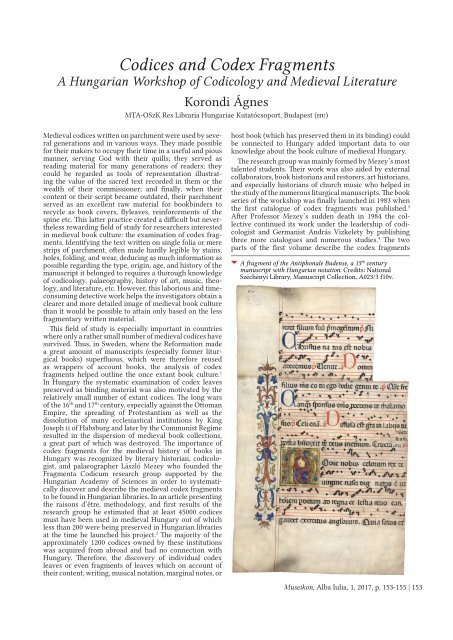Museikon_1_2017
Create successful ePaper yourself
Turn your PDF publications into a flip-book with our unique Google optimized e-Paper software.
Codices and Codex Fragments<br />
A Hungarian Workshop of Codicology and Medieval Literature<br />
Korondi Ágnes<br />
MTA-OSzK Res Libraria Hungariae Kutatócsoport, Budapest (hu)<br />
Medieval codices written on parchment were used by several<br />
generations and in various ways. They made possible<br />
for their makers to occupy their time in a useful and pious<br />
manner, serving God with their quills; they served as<br />
reading material for many generations of readers; they<br />
could be regarded as tools of representation illustrating<br />
the value of the sacred text recorded in them or the<br />
wealth of their commissioner; and finally, when their<br />
content or their script became outdated, their parchment<br />
served as an excellent raw material for bookbinders to<br />
recycle as book covers, flyleaves, reinforcements of the<br />
spine etc. This latter practice created a difficult but nevertheless<br />
rewarding field of study for researchers interested<br />
in medieval book culture: the examination of codex fragments.<br />
Identifying the text written on single folia or mere<br />
strips of parchment, often made hardly legible by stains,<br />
holes, folding, and wear, deducing as much information as<br />
possible regarding the type, origin, age, and history of the<br />
manuscript it belonged to requires a thorough knowledge<br />
of codicology, palaeography, history of art, music, theology,<br />
and literature, etc. However, this laborious and timeconsuming<br />
detective work helps the investigators obtain a<br />
clearer and more detailed image of medieval book culture<br />
than it would be possible to attain only based on the less<br />
fragmentary written material.<br />
This field of study is especially important in countries<br />
where only a rather small number of medieval codices have<br />
survived. Thus, in Sweden, where the Reformation made<br />
a great amount of manuscripts (especially former liturgical<br />
books) superfluous, which were therefore reused<br />
as wrappers of account books, the analysis of codex<br />
fragments helped outline the once extant book culture. 1<br />
In Hungary the systematic examination of codex leaves<br />
preserved as binding material was also motivated by the<br />
relatively small number of extant codices. The long wars<br />
of the 16 th and 17 th century, especially against the Ottoman<br />
Empire, the spreading of Protestantism as well as the<br />
dissolution of many ecclesiastical institutions by King<br />
Joseph ii of Habsburg and later by the Communist Regime<br />
resulted in the dispersion of medieval book collections,<br />
a great part of which was destroyed. The importance of<br />
codex fragments for the medieval history of books in<br />
Hungary was recognized by literary historian, codicologist,<br />
and palaeographer László Mezey who founded the<br />
Fragmenta Codicum research group supported by the<br />
Hungarian Academy of Sciences in order to systematically<br />
discover and describe the medieval codex fragments<br />
to be found in Hungarian libraries. In an article presenting<br />
the raisons d’être, methodology, and first results of the<br />
research group he estimated that at least 45000 codices<br />
must have been used in medieval Hungary out of which<br />
less than 200 were being preserved in Hungarian libraries<br />
at the time he launched his project. 2 The majority of the<br />
approximately 1200 codices owned by these institutions<br />
was acquired from abroad and had no connection with<br />
Hungary. Therefore, the discovery of individual codex<br />
leaves or even fragments of leaves which on account of<br />
their content, writing, musical notation, marginal notes, or<br />
host book (which has preserved them in its binding) could<br />
be connected to Hungary added important data to our<br />
knowledge about the book culture of medieval Hungary.<br />
The research group was mainly formed by Mezey’s most<br />
talented students. Their work was also aided by external<br />
collaborators, book historians and restorers, art historians,<br />
and especially historians of church music who helped in<br />
the study of the numerous liturgical manuscripts. The book<br />
series of the workshop was finally launched in 1983 when<br />
the first catalogue of codex fragments was published. 3<br />
After Professor Mezey’s sudden death in 1984 the collective<br />
continued its work under the leadership of codicologist<br />
and Germanist András Vizkelety by publishing<br />
three more catalogues and numerous studies. 4 The two<br />
parts of the first volume describe the codex fragments<br />
A fragment of the Antiphonale Budense, a 15 th century<br />
manuscript with Hungarian notation. Credits: National<br />
Széchényi Library, Manuscript Collection, A023/3 f10v.<br />
<strong>Museikon</strong>, Alba Iulia, 1, <strong>2017</strong>, p. 153-155 | 153


